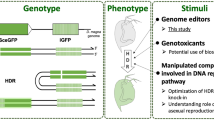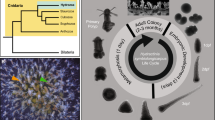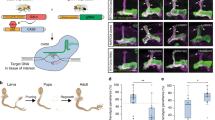Abstract
The freshwater polyp Hydra is a cnidarian used as a model organism in a number of fields, including the study of the origin and evolution of developmental mechanisms, aging, symbiosis and host–microbe interactions. Here, we describe a procedure for the establishment of stable transgenic Hydra lines by embryo microinjection. The three-stage protocol comprises (i) the design and preparation of a transgenic construct, (ii) the microinjection of the vector into early embryos of Hydra vulgaris, and (iii) the selection and enrichment of mosaic animals in order to develop uniformly transgenic clonal lines. The preparation of a transgenic construct requires ~2 weeks, and transgenic lines can be obtained within 3 months. The method allows constitutive or inducible gain- and loss-of-function approaches, as well as in vivo tracing of individual cells. Hydra polyps carrying transgenic cells reveal functional properties of the ancestral circuitry controlling animal development.
This is a preview of subscription content, access via your institution
Access options
Access Nature and 54 other Nature Portfolio journals
Get Nature+, our best-value online-access subscription
$29.99 / 30 days
cancel any time
Subscribe to this journal
Receive 12 print issues and online access
$259.00 per year
only $21.58 per issue
Buy this article
- Purchase on Springer Link
- Instant access to full article PDF
Prices may be subject to local taxes which are calculated during checkout






Similar content being viewed by others
Data availability
All data generated or analyzed during the current study are included in this paper. The raw data used in the example results are available from the corresponding authors upon reasonable request.
References
Galliot, B. Hydra, a fruitful model system for 270 years. Int. J. Dev. Biol. 56, 411–423 (2012).
Siebert, S., Anton-Erxleben, F. & Bosch, T. C. G. Cell type complexity in the basal metazoan Hydra is maintained by both stem cell based mechanisms and transdifferentiation. Dev. Biol. 313, 13–24 (2008).
Gee, L. et al. β-catenin plays a central role in setting up the head organizer in Hydra. Dev. Biol. 340, 116–124 (2010).
Hemmrich, G. et al. Molecular signatures of the three stem cell lineages in Hydra and the emergence of stem cell function at the base of multicellularity. Mol. Biol. Evol. 29, 3267–3280 (2012).
Boehm, A.-M. et al. FoxO is a critical regulator of stem cell maintenance in immortal Hydra. Proc. Natl. Acad. Sci. USA 109, 19697–19702 (2012).
Domazet-Lošo, T. et al. Naturally occurring tumours in the basal metazoan Hydra. Nat. Commun. 5, 4222 (2014).
Klimovich, A. et al. Non-senescent Hydra tolerates severe disturbances in the nuclear lamina. Aging 10, 951–972 (2018).
Anton-Erxleben, F., Thomas, A., Wittlieb, J., Fraune, S. & Bosch, T. C. G. Plasticity of epithelial cell shape in response to upstream signals: a whole-organism study using transgenic Hydra. Zoology 112, 185–194 (2009).
Nishimiya-Fujisawa, C. & Kobayashi, S. Roles of germline stem cells and somatic multipotent stem cells in Hydra sexual reproduction. in Reproductive and Developmental Strategies: The Continuity of Life (eds Kobayashi, K., Kitano, T., Iwao, Y. & Kondo, M.) 123–155 (Springer Japan, 2018).
Boehm, A.-M. & Bosch, T. C. G. Migration of multipotent interstitial stem cells in Hydra. Zoology 115, 275–282 (2012).
Mortzfeld, B. M. & Bosch, T. C. G. Eco-aging: stem cells and microbes are controlled by aging antagonist FoxO. Curr. Opin. Microbiol. 38, 181–187 (2017).
Mortzfeld, B. M., Taubenheim, J., Fraune, S., Klimovich, A. V. & Bosch, T. C. G. Stem cell transcription factor FoxO controls microbiome resilience in Hydra. Front. Microbiol. 9, 629 (2018).
Koizumi, O. Origin and evolution of the nervous system considered from the diffuse nervous system of cnidarians. in The Cnidaria, Past, Present and Future (eds Goffredo, S. & Dubinsky, Z.) 73–91 (Springer, Basel, Switzerland, 2016).
Bosch, T. C. G. et al. Back to the basics: cnidarians start to fire. Trends Neurosci. 40, 92–105 (2017).
Klimovich, A. V & Bosch, T. C. G. Rethinking the role of the nervous system: lessons from the Hydra holobiont. BioEssays e1800060 (2018).
Dupre, C. & Yuste, R. Non-overlapping neural networks in Hydra vulgaris. Curr. Biol. 27, 1085–1097 (2017).
Rentzsch, F., Juliano, C. & Galliot, B. Modern genomic tools reveal the structural and cellular diversity of cnidarian nervous systems. Curr. Opin. Neurobiol. 56, 87–96 (2019).
Bosch, T. C. G. Rethinking the role of immunity: lessons from Hydra. Trends Immunol. 35, 495–502 (2014).
Augustin, R., Fraune, S., Franzenburg, S. & Bosch, T. C. G. Where simplicity meets complexity: hydra, a model for host–microbe interactions. in Recent Advances on Model Hosts (eds Mylonakis, E., Ausubel, F. M., Gilmore, M. & Casadevall, A.) 71–81 (Springer, Basel, Switzerland, 2012).
Franzenburg, S. et al. MyD88-deficient Hydra reveal an ancient function of TLR signaling in sensing bacterial colonizers. Proc. Natl. Acad. Sci. USA 109, 19374–19379 (2012).
Franzenburg, S. et al. Distinct antimicrobial peptide expression determines host species-specific bacterial associations. Proc. Natl. Acad. Sci. USA 110, E3730–E3738 (2013).
Augustin, R. et al. A secreted antibacterial neuropeptide shapes the microbiome of Hydra. Nat. Commun. 8, 698 (2017).
Chapman, J. A. et al. The dynamic genome of Hydra. Nature 464, 592–596 (2010).
Hemmrich, G. & Bosch, T. C. G. Compagen, a comparative genomics platform for early branching metazoan animals, reveals early origins of genes regulating stem-cell differentiation. Bioessays 30, 1010–1018 (2008).
Wittlieb, J., Khalturin, K., Lohmann, J. U., Anton-Erxleben, F. & Bosch, T. C. G. Transgenic Hydra allow in vivo tracking of individual stem cells during morphogenesis. Proc. Natl. Acad. Sci. USA 103, 6208–6211 (2006).
Steele, R. E. Trembley’s polyps go transgenic. Proc. Natl. Acad. Sci. USA 103, 6415–6416 (2006).
Wein, T. et al. Carrying capacity and colonization dynamics of Curvibacter in the Hydra host habitat. Front. Microbiol. 9, 443 (2018).
Murillo-Rincon, A. P. et al. Spontaneous body contractions are modulated by the microbiome of Hydra. Sci. Rep. 7, 15937 (2017).
Juliano, C. E., Lin, H. & Steele, R. E. Generation of transgenic Hydra by embryo microinjection. J. Vis. Exp. 2014, 51888 (2014).
Böttger, A. et al. GFP expression in Hydra: lessons from the particle gun. Dev. Genes Evol. 212, 302–305 (2002).
Dana, C. E., Glauber, K. M., Chan, T. A., Bridge, D. M. & Steele, R. E. Incorporation of a horizontally transferred gene into an operon during cnidarian evolution. PLoS ONE 7, e31643 (2012).
Milde, S. et al. Characterization of taxonomically restricted genes in a phylum-restricted cell type. Genome Biol. 10, R8 (2009).
Khalturin, K. et al. A novel gene family controls species-specific morphological traits in Hydra. PLoS Biol. 6, e278 (2008).
Khalturin, K. et al. Transgenic stem cells in Hydra reveal an early evolutionary origin for key elements controlling self-renewal and differentiation. Dev. Biol. 309, 32–44 (2007).
Juliano, C. E. et al. PIWI proteins and PIWI-interacting RNAs function in Hydra somatic stem cells. Proc. Natl. Acad. Sci. USA 111, 337–342 (2014).
Iachetta, R. et al. Real time dynamics of β-catenin expression during Hydra development, regeneration and Wnt signalling activation. Int. J. Dev. Biol. 62, 311–318 (2018).
Nakamura, Y., Tsiairis, C. D., Özbek, S. & Holstein, T. W. Autoregulatory and repressive inputs localize Hydra Wnt3 to the head organizer. Proc. Natl. Acad. Sci. USA 108, 9137–9142 (2011).
Noro, Y. et al. Regionalized nervous system in Hydra and the mechanism of its development. Gene Expr. Patterns 31, 42–59 (2019).
Lippincott-Schwartz, J. & Patterson, G. H. Development and use of fluorescent protein markers in living cells. Science 300, 87–91 (2003).
Li, X. et al. Generation of destabilized green fluorescent protein as a transcription reporter. J. Biol. Chem. 273, 34970–34975 (1998).
Bosch, T., Anton-Erxleben, F., Hemmrich, G. & Khalturin, K. The Hydra polyp: nothing but an active stem cell community. Dev. Growth Differ. 52, 15–25 (2010).
Buzgariu, W., Crescenzi, M. & Galliot, B. Robust G2 pausing of adult stem cells in Hydra. Differentiation 87, 83–99 (2014).
Wenger, Y., Buzgariu, W. & Galliot, B. Loss of neurogenesis in Hydra leads to compensatory regulation of neurogenic and neurotransmission genes in epithelial cells. Philos. Trans. R. Soc. B Biol. Sci. 371, 20150040 (2016).
Siebert, S. et al. Stem cell differentiation trajectories in Hydra resolved at single-cell resolution. Preprint at bioRxiv, https://doi.org/10.1101/460154 (2018).
Lenhoff, M. & Dubois, R. A. Y. Mass culture of Hydra: an improved method and its application to other aquatic invertebrates. Lab. Anim. 4, 139–154 (1970).
Lenhoff, H. M. Culturing large numbers of Hydra in Hydra: Research Methods 53–62 (Springer, New York, 1983).
Bossert, P. & Galliot, B. How to use Hydra as a model system to teach biology in the classroom. Int. J. Dev. Biol. 56, 637–652 (2012).
Johnson, E. M. & Gabel, B. E. G. An artificial ‘embryo’ for detection of abnormal developmental biology. Toxicol. Sci. 3, 243–249 (1983).
Johnson, E. M. & Gabel, B. E. G. Application of the Hydra assay for rapid detection of developmental hazards. J. Am. Coll. Toxicol. 1, 57–71 (1982).
Renfer, E. & Technau, U. Meganuclease-assisted generation of stable transgenics in the sea anemone Nematostella vectensis. Nat. Protoc. 12, 1844 (2017).
Bosch, T. C. & David, C. N. Male and female stem cells and sex reversal in Hydra polyps. Proc. Natl. Acad. Sci. USA 83, 9478–9482 (1986).
Nishimiya-Fujisawa, C. & Kobayashi, S. Germline stem cells and sex determination in Hydra. Int. J. Dev. Biol. 52, 499–508 (2012).
Glauber, K. M. et al. A small molecule screen identifies a novel compound that induces a homeotic transformation in Hydra. Development 140, 4788–4796 (2013).
Bosch, T. C. G. & David, C. N. Stem cells of Hydra magnipapillata can differentiate into somatic cells and germ line cells. Dev. Biol. 121, 182–191 (1987).
Nishimiya-Fujisawa, C. & Sugiyama, T. Genetic analysis of developmental mechanisms in Hydra. XXII. Two types of female germ stem cells are present in a male strain of Hydra magnipapillata. Dev. Biol. 172, 324–336 (1995).
Magie, C. R., Daly, M. & Martindale, M. Q. Gastrulation in the cnidarian Nematostella vectensis occurs via invagination not ingression. Dev. Biol. 305, 483–497 (2007).
Rentzsch, F., Fritzenwanker, J. H., Scholz, C. B. & Technau, U. FGF signalling controls formation of the apical sensory organ in the cnidarian Nematostella vectensis. Development 135, 1761–1769 (2008).
Layden, M. J., Röttinger, E., Wolenski, F. S., Gilmore, T. D. & Martindale, M. Q. Microinjection of mRNA or morpholinos for reverse genetic analysis in the starlet sea anemone, Nematostella vectensis. Nat. Protoc. 8, 924–934 (2013).
Lommel, M. et al. Genetic knockdown and knockout approaches in Hydra. Preprint at https://www.biorxiv.org/content/10.1101/460154v1 (2017).
Bosch, T. C. G., Augustin, R., Gellner, K., Khalturin, K. & Lohmann, J. U. In vivo electroporation for genetic manipulations of whole Hydra polyps. Differ. Orig. Artic. 70, 140–147 (2002).
Miljkovic, M., Mazet, F. & Galliot, B. Cnidarian and bilaterian promoters can direct GFP expression in transfected Hydra. Dev. Biol. 246, 377–390 (2002).
Chera, S. et al. Silencing of the Hydra serine protease inhibitor Kazal1 gene mimics the human SPINK1 pancreatic phenotype. J. Cell Sci. 119, 846–857 (2006).
Galliot, B., Miljkovic-Licina, M., Ghila, L. & Chera, S. RNAi gene silencing affects cell and developmental plasticity in Hydra. C. R. Biol. 330, 491–497 (2007).
Ambrosone, A., Marchesano, V., Tino, A., Hobmayer, B. & Tortiglione, C. Hymyc1 downregulation promotes stem cell proliferation in Hydra vulgaris. PLoS ONE 7, e30660 (2012).
Schwentner, M. & Bosch, T. C. G. Revisiting the age, evolutionary history and species level diversity of the genus Hydra (Cnidaria: Hydrozoa). Mol. Phylogenet. Evol. 91, 41–55 (2015).
Bosch, T. C. G. et al. How do environmental factors influence life cycles and development? An experimental framework for early-diverging metazoans. BioEssays 36, 1185–1194 (2014).
Hamada, M. et al. Metabolic co-dependence drives the evolutionarily ancient Hydra–Chlorella symbiosis. Elife 7, e35122 (2018).
Revilla-i-Domingo, R., Schmidt, C., Zifko, C. & Raible, F. Establishment of transgenesis in the demosponge Suberites domuncula. Genetics 210, 435–443 (2018).
Hemmrich, G., Anokhin, B., Zacharias, H. & Bosch, T. C. G. Molecular phylogenetics in Hydra, a classical model in evolutionary developmental biology. Mol. Phylogenet. Evol. 44, 281–290 (2007).
Martínez, D. E. et al. Phylogeny and biogeography of Hydra (Cnidaria: Hydridae) using mitochondrial and nuclear DNA sequences. Mol. Phylogenet. Evol. 57, 403–410 (2010).
Nakamura, Y., Gojobori, T. & Ikemura, T. Codon usage tabulated from international DNA sequence databases: status for the year 2000. Nucleic Acids Res. 28, 292 (2000).
Oesterle, A. Pipette Cookbook 2015: P-97 & P-1000 Micropipette Pullers (Sutter Instrument, Novato, CA, 2015).
Acknowledgements
We are grateful to F. Anton-Erxleben for assistance with confocal microscopy and to J. Lohmann and K. Khalturin for contributions to the development of the genetic constructs. This work was supported in part by the Deutsche Forschungsgemeinschaft (DFG) (grant CRC 190, ‘Mechanisms and factors of gene activation’; grant nos. 846/6-1-4, 848/13-1-4, and 848/15-1; grant CRC 1182, ‘Origin and function of Metaorganisms’; and grants from the DFG Clusters of Excellence ‘Inflammation at Interfaces’ and ‘The Future Ocean’). A.K. was supported by a fellowship from the Alexander von Humboldt Foundation. T.C.G.B. acknowledges support from the Canadian Institute for Advanced Research (CIFAR).
Author information
Authors and Affiliations
Contributions
A.K. and T.C.G.B. conceived the paper. J.W. and A.K. generated the data and took photos. A.K., J.W. and T.C.G.B. wrote the manuscript.
Corresponding authors
Ethics declarations
Competing interests
The authors declare no competing interests.
Additional information
Journal peer review information: Nature Protocols thanks Brigitte Galliot, Rob Steele and other anonymous reviewer(s) for their contribution to the peer review of this work.
Publisher’s note: Springer Nature remains neutral with regard to jurisdictional claims in published maps and institutional affiliations.
Related links
Key references using this protocol
Wittlieb, J., Khalturin, K., Lohmann, J. U., Anton-Erxleben, F. & Bosch, T. C. G. Proc. Natl. Acad. Sci. USA 103, 6208–6211 (2006): https://doi.org/10.1073/pnas.0510163103
Siebert, S., Anton-Erxleben, F. & Bosch, T. C. G. Dev. Biol. 313, 13–24 (2008): https://doi.org/10.1016/j.ydbio.2007.09.007
Klimovich, A. et al. Aging 10, 951–972 (2018): https://doi.org/10.18632/aging.101440
Integrated supplementary information
Supplementary Figure 1 Shortening of tentacles is the first indicator of a polyp’s compromised health.
A healthy Hydra polyp (left) typically has long tentacles armed with nematocytes and displays conspicuous periodically recurring contractions of the body followed by a passive re-extension. Sick polyps (right) can be recognized by shortened tentacles with rounded knobs at their ends (arrowheads). Diseased polyps stay in a permanently elongated or contracted state. Irregular or inappropriate washing of the culture after feeding or exposure to some toxic chemicals from the plastic are main causes for emergence of such diseased polyps.
Supplementary information
Supplementary information
Supplementary Figure 1
Supplementary Video 1
Microinjection of a Hydra embryo. (00:00–00:04) A female polyp with a fertilized egg undergoing the first cleavage. (00:05–00:17) Microinjection setup ready for injection. The tips of both the holding capillary (left) and the injection needle (right) are submerged in the injection chamber. (00:18–00:33) The embryo is fixed by the holding capillary (left) and pierced with the injection needle (right) to deliver the transgene into it. (00:34–00:40) The injected embryo continues its development and undergoes a series of cleavages. (00:41–00:43) Three transgenic embryos at the cuticle stage with clearly visible eGFP fluorescence. (00:44–00:51) Transgenic polyp hatches from one of the embryos.
Rights and permissions
About this article
Cite this article
Klimovich, A., Wittlieb, J. & Bosch, T.C.G. Transgenesis in Hydra to characterize gene function and visualize cell behavior. Nat Protoc 14, 2069–2090 (2019). https://doi.org/10.1038/s41596-019-0173-3
Received:
Accepted:
Published:
Issue Date:
DOI: https://doi.org/10.1038/s41596-019-0173-3
This article is cited by
-
Automatic monitoring of neural activity with single-cell resolution in behaving Hydra
Scientific Reports (2024)
-
Articulating the “stem cell niche” paradigm through the lens of non-model aquatic invertebrates
BMC Biology (2022)
-
Beyond Lynn Margulis’ green hydra
Symbiosis (2022)
Comments
By submitting a comment you agree to abide by our Terms and Community Guidelines. If you find something abusive or that does not comply with our terms or guidelines please flag it as inappropriate.



